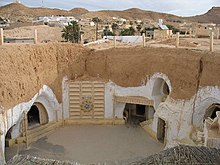Why are Crater Gardens warm, a great questions. I'll list off some of the reasons below, though I'm sure these are the ones I've noticed the most.
The stones are buried 3/4 of the way in the earth with one exposed face, like solar radiators or a passive solar house, trapping the sun's energy throughout the day and releasing it at night.
The water in the bottom of the garden is also a huge thermal mass absorbing the energy from the sun for more long term storage.
Water gives off heat when it freezes, so it's a great buffer against early and late frosts.
The sunken nature of the garden protects it from wind, this has a number of effects on the micro-climate. Because the wind has been reduced the desiccation and loss of moisture has been reduced as well. This increases the moisture of the earth and it's thermal conductivity as well. This makes all of the earth a better thermal mass as well. All of this thermal mass would not have such a big benefit if all of the heat were blown off by the wind, but because of the wind protection the garden is able to hold onto all of this heat. Crater gardens also have a higher humidity in the air, due to this protection, and so the air acts as another buffer, while also increasing the conduction between the various elements.
Stone and water both have great thermal absorption. Stone diffuses that heat on a great daily cycle, while water holds onto the heat longer and acts as a more long term buffer. Stones and water are integrated to increase the heat exchange between sun, water, air, and earth.
Our last frost/snow was June 20th and our first frost was August 23rd. For those counting that's a pretty short growing season. What I noticed was that even the frost sensitive things did great in the Crater garden, particularly around the stones, while the frost sensitive plants planted just up the hill from the Crater garden died with the frosts. Temperature is not as important as effective climate for the plants. Often times it's more important how quickly the temperature changes rather than how much the temperature changes. For example if you have a tree like an apricot that is borderline because it blossoms early and your climate frosts late, it is best to plant this on the west side of a house rather than the east or south side. This is because the blossoms try to become active as soon as the sun hits them. If the sun hits the blossoms early in the morning when it is cold the plant will drop it's blossoms. If instead the blossom has time to slowly warm up and the sun is not on the tree until later in the day once it is warmer outside, then you will have a better chance for success.
Crater gardens certainly hold the snow longer, particularly on the north facing aspects, but much like the apricot that doesn't get sun until later in the day this can be an advantage. Some of the life in the soil survives a frost but plenty of organisms have their cell rupture once the ground freezes. This leads up to a huge flush of nutrient and vitality once the ground thaws. A common problem in alpine climates right now is de-nitrification of the soil. The reason for this is that the snow packs are thinner and the alpine soils are beginning to thaw earlier in the year. Because they thaw and freeze more than they used to (as apposed to a deep snow pack keeping the ground frozen and a stable temperature till spring) much of this nutrient is vaporized. The crystallized nutrient is flushed through the system before plants, bacteria, fungi, and soil organisms can make use of it.
Those are my observations so far with Crater Gardens.









